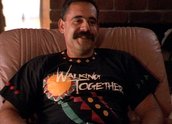


Harold (1994)
Synopsis
Harold Blair was the first Aboriginal person to sing on national radio. He studied singing in the USA and his tenor voice was heard throughout the world. This biographical documentary about his life honours his achievements in music and examines the role that Blair played in having Aboriginal Australians recognised.
The film uses archival footage, sound recordings, still photographs and interviews with his wife, Dorothy, and their two children plus Blair’s sister Meryl Thompson and friends.
Curator’s notes
A great story of personal triumph and achievement about a little-known Australian, Harold also looks at the changing attitudes in the white community to the policy of assimilation and the part that Blair played in breaking down stereotypes.
Writer and director Steve Thomas has made a wide variety of documentaries. His credits include Welcome to Woomera, Family Foibles, Least Said, Soonest Mended and Black Man’s Houses.
Secondary curator’s notes
by Romaine MoretonHarold Blair was an unknown, discovered at the age of 17 while working as a tractor driver at a sugar mill in Fairymead. Born in 1924, Harold lived during a period in Australian history where Aboriginal peoples’ movements were heavily policed. As an Indigenous person deemed to be of 'mixed blood’, Harold could – and did – sign a Certificate of Exemption that released him from these restrictions. The colloquial term for the exemption was ‘dog tag’. In taking up the exemption, Harold was forced to cut ties with his family and community.
Harold is a documentary about the life of a gifted singer who found a sense of his own humanity through travelling abroad. It was through this exposure to other cultures and social political environments that Harold gained a wider context in which to view the living situation of Indigenous peoples in Australia. This emergent awareness politicised Harold’s voice, with Harold Blair becoming increasingly driven by the plight of his people.
Harold as a documentary gives us a good sense of the man, artist, father, husband, and cultural ambassador. Featuring interviews with wife Dorothy, daughter Nerida and son Warren, we get the sense of the large presence Harold Blair had – not only in the artistic world, but within his private world also. The pressure of being such a prominent figure during his career was in fact one shared by his family. There is good archival footage used in this documentary as well as an opportunity to hear Harold Blair sing. A big voice, a big man, who carried on his shoulders huge responsibilities.
Harold is the story of a man with an incredible life story, and we get a sense of Harold’s desire to contribute to the betterment of others through his talent and art. But we also get a sense of how ill-prepared white society in Australia was in making a space for the creative intelligence of someone like Harold Blair. We see how this pressure shaped the lives of his family members, living in the scrutiny of the public gaze as a result of Harold’s talent but also because of the interracial marriage between Harold and Dorothy. These are all part of the Blair legacy to Indigenous peoples.
There is a sense of sadness in this film in witnessing the lived experience of the Blair family that was forged by the racist and racialised policies of the time but, ultimately, Harold is a story of the triumph of a man who rose to the challenge.
- Overview
- Curator’s notes
- Video 3 clips

- Principal credits
- Find a copy
- Make a comment
- Map
- Add your review




